| |
| |
Photographer,
Location |
Images |
Comments |
|
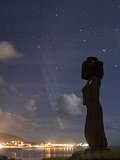
|
Dennis Mammana,
Easter Island, Chile
Jan. 24, 2007 |
#1, more |
The view from
Easter Island, despite fighting light pollution near town,
clouds, a fading comet AND some weird gastro-intestinal
bug that has nearly everyone in my group sick!
Photo
Details: Canon
20D, 24mm
lens, f/2, 10s at ISO800.
|
|
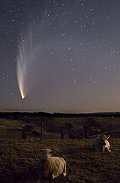
|
Tim
Thorpe,
Southern Mt Lofty Ranges near the Meadows township.
Jan. 23, 2007 |
#1,
#2, more |
The
23rd was no where near as speccy as the 22nd. Still the
cows and sheep enjoyed the show, or rather watching me enjoy
the show! Clouds rolled in as the evening ended.
Photo
details: Nikon
D70 @ ISO 1000 |
|
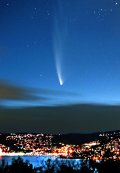
|
Bruce
Smart,
View over the city of Hobart, Tasmania,Australia.
Jan. 23, 2007 |
#1 |
The
clouds cleared for an hour or so, for the first time in
the past week. Two minute exposure on 100iso film produced
obvious trailing effect, but allowed for some sky detail.
|
|
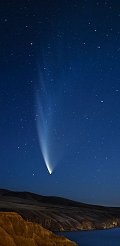
|
David
Summerhayes,
Sellick's Beach - Near Adelaide South Australia
Jan. 24, 2007 |
#1 |
The
comet was beautiful and the moonlight lit up the landscape
perfectly |
|
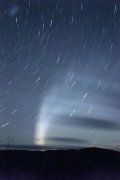
|
Dylan
O'Donnell,
Snowy Mountains, Australia
Jan. 24, 2007 |
#1,
more |
Comet McNaught's
tail shifting with the stars during a 20 minute exposure
from the Snowy Mountains.
|
|
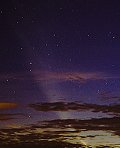
|
Olivier Vandeginste,
Le Port, Ile de la Reunion, Indian Ocean
Jan. 24, 2007 |
#1,
#2, more |
After 2 weeks
of clouds finally an open sky. The comets magnitude is rising
fast but it was still visible with the eye.
Photo
details: Canon
EOS 400D, ISO 400, f=2.8, 30s exposure
|
|
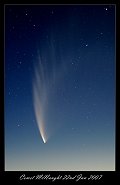
|
Leigh
Thomas,
Warrnambool, Victoria, Australia.
Jan. 22, 2007 |
#1 |
Comet
McNaught as seen from southern Australia. |
|

|
Brian
Whittaker,
Airborne 35,000 feet over West Africa, approx 10N 004E. (Northern
Hemisphere)
Jan. 21, 2007 |
#1,
#2, more |
Thanks
to the exclusive participant contributions on SpaceWeather.com,
I was able to look for and find this incredible Tail towering
over 30 degrees in the sky. A truely memorable sight that
I almost missed. Who would have believed that this exceptional
Tail would be so visible well over an hour after sunset
with the Coma and normal tail never even able to be seen
from this northern latitude. |
|
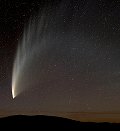
|
David Headland,
Central Otago, Sth Island, New Zealand
Jan. 24, 2007 |
#1 |
Simply put...
an awesome sight!!!
Photo
details: Canon
EOS-20D, 50mm
lens, 25sec exp f/2.8 ISO 1600. Image is composed of
10 separate photos stitched together (2 rows of 5)
|
|
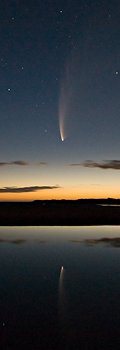
|
John
Lamb,
Dunedin New Zealand
Jan. 23, 2007 |
#1,
|
Photo
details: Nikon
D200, Nikkor
12 - 24 mm lens, f/4, 400 ISO, 30 seconds |
|
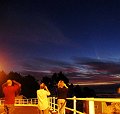
|
Danut
Ionescu,
Auckland, New Zealand
Jan. 23, 2007 |
#1,
more |
The
comet is still beautiful!
Photo
details: Canon
A510, 15 sec, ISO 200, f/2.6, 35mm
lens |
|
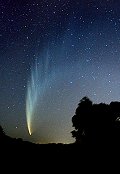
|
David
O'Carroll,
Scott Creek, Near Adelaide, South Australia
Jan. 23, 2007 |
#1 |
While
still a spectacular object, glare from the moon is beginning
to affect the view of McNaught.
Photo
details: Nikon
D70, 18-70mm
lens, @ 18mm, f3.5. 144 second exposure guided (piggyback)
on a 6 inch catadioptric telescope. |
more
images:
from Mendonca Jr.
of Pousada Cainã - PR - Brazil; from
Bernard Billedo of Tauranga, New Zealand; from
I Turner of Katikati, New Zealand; from
Bruce McLennan of Dunedin, South Island, New Zealand
|
|